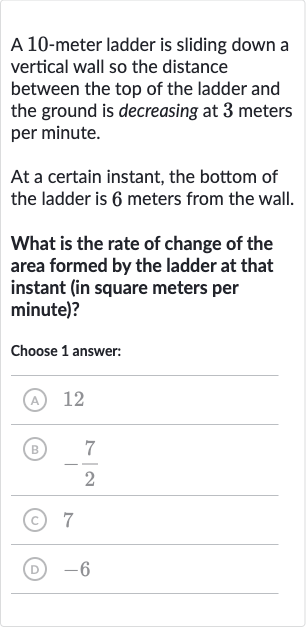AI tutor
Welcome to Bytelearn!
Let’s check out your problem:

A -meter ladder is sliding down a vertical wall so the distance between the top of the ladder and the ground is decreasing at meters per minute.At a certain instant, the bottom of the ladder is meters from the wall.What is the rate of change of the area formed by the ladder at that instant (in square meters per minute)?Choose answer:(A) (B) (C) (D)
Full solution
Q. A -meter ladder is sliding down a vertical wall so the distance between the top of the ladder and the ground is decreasing at meters per minute.At a certain instant, the bottom of the ladder is meters from the wall.What is the rate of change of the area formed by the ladder at that instant (in square meters per minute)?Choose answer:(A) (B) (C) (D)
- Triangle Area Formula: The ladder forms a right triangle with the wall and the ground. The area of a right triangle is .
- Variables and Area Calculation: Let be the distance from the bottom of the ladder to the wall, and be the distance from the top of the ladder to the ground. The area .
- Pythagorean Theorem Application: Given that the ladder is meters long, by the Pythagorean theorem, we have .
- Differentiation for Rates of Change: Differentiate both sides with respect to time to find the rates of change: .
- Given Rate of Change: We know that meters per minute (since the top is going down, it's negative), and we need to find .
- Substitution for Variables: Substitute meters and meters into the differentiated equation.
- Equation Simplification: Now we have .
- Solving for : Solve for : .
- Final Rate Calculation: Add to both sides: .
- Area Rate of Change Formula: Divide by : meters per minute.
- Substitution for Area Rate: Now we find the rate of change of the area .
- Area Rate Calculation: Substitute , , , and into the equation for .
- Area Rate Calculation: Substitute , , , and into the equation for .Calculate .
- Area Rate Calculation: Substitute , , , and into the equation for .Calculate ..
- Area Rate Calculation: Substitute , , , and into the equation for .Calculate .. square meters per minute.
More problems from Calculate unit rates with fractions
QuestionGet tutor help
QuestionGet tutor help
QuestionGet tutor help
QuestionGet tutor help
QuestionGet tutor help
QuestionGet tutor help
QuestionGet tutor help
QuestionGet tutor help
QuestionGet tutor help
